一. 線程的概念
1.什么是線程
線程是進程內部的一個執行流,是進程調度的基本單位。它具有輕量的特點,它的創建和銷毀所消耗的資源更少,線程間切換比進程間切換消耗的資源更少;它與進程共享一張虛擬地址空間表,通過進程來給線程執行流分配資源;同時,每個線程都是獨立執行的,擁有自己的程序計數器和上下文切換。
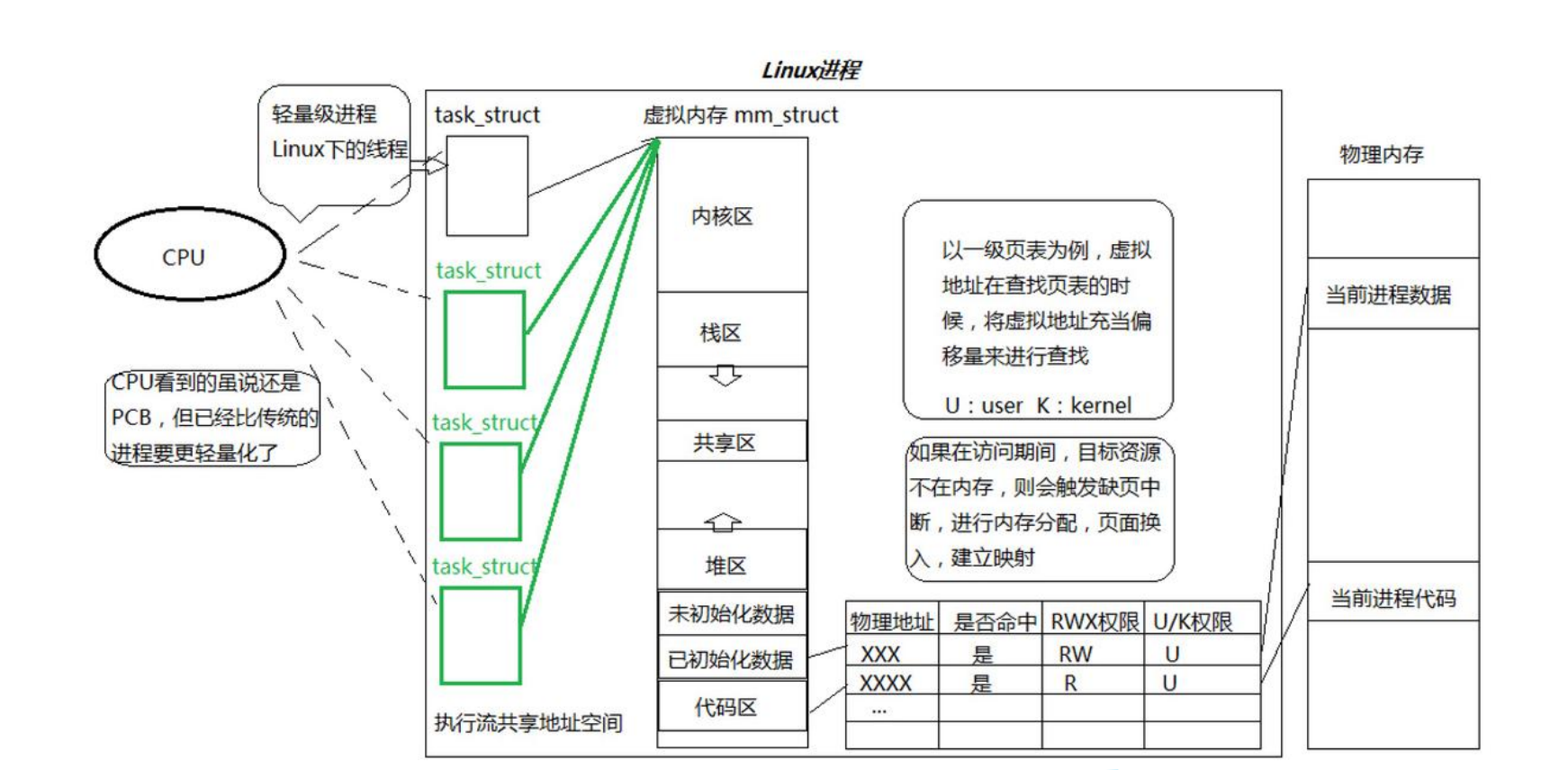
簡單來說在Linux下,一個進程由多個 task_struct ,一張虛擬地址空間表和頁表構成。而線程就是一個 task_struct ,進程內部的一個執行流,所有的線程都指向同一張虛擬地址空間表,讓進程共同管理。這樣我們就可以對所有線程的資源進行劃分,劃分為堆區棧區共享區等等。通過一張頁表映射到物理內存當中。
總的來說,線程就是一個 task_struct ,通過共同指向同一張虛擬地址空間的方式實現了共同管理,降低了創建調度銷毀成本。
2.深刻理解虛擬地址空間
在虛擬地址空間中,頁表用于映射虛擬地址空間到實際的物理內存。我們在管理虛擬地址空間的時候,它的地址是連續的,而物理地址空間則是可以分散碎片的。在虛擬地址空間中,我們存儲同一個資源的時候地址空間需要連續,但在物理地址當中,我們會將同類型的資源盡可能放到一處(這樣可以節省空間),無論是哪個線程都可以將數據進行整合。
有了虛擬地址空間和物理地址空間,那么我們如何將他們連接起來呢?再加一層頁表就好。
在 Linux 當中,頁表是由,三級頁表組成。一級頁表是頁表目錄,其中存儲著各個頁表的地址;二級目錄是各個頁表,頁表指向各個頁幀的地址(4 KB);三級頁表就是頁幀,每個頁幀由 4 KB 構成。在虛擬地址空間中,每個數據在虛擬地址空間下都有一個 32 字節的地址,這 32 個字節需要分為 10 + 10 + 12 來進行閱讀,首先定位到頁表目錄當中,前10個字節,用于在頁表目錄當中找到對應的頁表;中間的10個字節用于在當前頁表當中找到對應的頁幀;最后的12個字節用于對頁幀的起始位置的偏移量,這樣我們就能通過虛擬地址找到相對于的物理地址
下面是一個簡化圖

有了頁幀,該如何管理呢? 先描述再組織,操作系統引入了 struct page 結構。對于每個頁幀,都有一個 struct page 對它進行相應的管理。
下面我來介紹一下 struct page 的結構構成。
該結構主要用于管理記錄,跟蹤頁幀的使用狀態,頁針的歸屬,管理頁幀的映射關系,回收頁幀等等。
首先是狀態標識(flags),用于記錄頁幀的基本狀態,是被鎖定被修改還是內核保留;引用計數(_refcount)記錄該頁幀被引用的次數;映射關系(mapping + index)mapping 指向該文件的存儲頁,index 用于指向在該頁下的偏移量。
總結:
1. 虛擬地址和物理地址管理,通過頁表進行映射,使得其完成了解耦的操作。
2. 頁表按需創建和分頁機制有效的節省了空間消耗。
3.線程的優缺點
(1)優點
線程的創建相比于進程的創建代價要小很多且占用資源少,線程只需要創建 task_struct 掛接到虛擬地址空間上即可,而進程的創建就要涉及虛擬地址空間頁表等等資源;線程切換比進程切換效率高,如果要進行進程間的切換,就需要連同虛擬地址空間等進行統一切換,而線程只需要切換 task_struct 和上下文資源即可;線程可以利用多處理器進行并發運行,提高 IO 效率和計算效率;
(2)缺點
線程共享進程的地址空間,因此可以訪問到當前的共享資源,這就導致,若缺乏同步機制,線程會引發數據競爭,導致程序異常;當線程過多時,容易導致資源限制,首先每個線程都有自己的獨立線程棧在內存當中,大小為 8 MB ,若線程過多就容易導致內存空間耗盡。其次,若線程過多,CPU的調度開銷也對應的增加,CPU 將時間花在了不斷調度線程中,導致 CPU 利用率下降。最后,每個線程創建都會在內核當中創建一個 TCB 資源,這也就導致了高頻創建銷毀會給內核增加負擔。進程擁有較高的獨立性,即使程序出錯進程崩潰,這也不會影響其他的進程運行,但如果線程崩潰,可能會導致整個進程都退出。
二. 線程的控制
1.線程創建
pthread_create:
#include <pthread.h> int pthread_create(pthread_t *thread, const pthread_attr_t *attr,void *(*start_routine)(void*),void *arg);參數說明:
thread:獲取創建成功的線程 ID ,該參數是一個輸出型參數。
attr:用于設置進程屬性,傳入NULL 表示使用默認值。
start_routine:返回值和參數均為 void* 的函數指針。該參數表示線程例程,即后續線程需要執行的函數。
arg:傳給線程實例的參數。
返回值:
成功返回0,失敗返回錯誤碼。
下面我們來看一個示例,讓一個主線程創建一個新線程
當一個程序啟動時,就有一個進程被操作系統創建,于此同時一個線程也立刻運行,這個線程就是主線程。
#include <iostream> #include <pthread.h> #include <unistd.h> using namespace std;void *startRoutine(void* args) {while(true){cout<<"線程正在運行"<<endl;sleep(1);} }int main() {pthread_t tid;int n = pthread_create(&tid,nullptr,startRoutine,(void*)"thread-1");cout<<"new thread id:"<<tid<<endl;while(true){cout<<"main pthread 正在運行"<<endl;sleep(1);}return 0; }運行結果:
當我們想獲取線程 id 時,可以使用 pthread_self 函數,我們來看下面的代碼
#include <iostream> #include <pthread.h> #include <unistd.h> using namespace std;static void Print(const char* name,pthread_t tid) {cout<<name<<" 正在運行"<<tid<<endl; }void *routine(void* argv) {const char* name = static_cast<const char*>(argv);while(true){Print(name,pthread_self());sleep(1);} }int main() {pthread_t tid;int n = pthread_create(&tid,nullptr,routine,(void*)"thread");while(true){cout<<"main thread run"<<endl;sleep(1);}return 0; }
下面是運行結果:
在線程運行中,調用了 pthread_self 函數將當前線程的tid傳給了函數進行調用。
2.線程終止
終止一個線程有三種方法:
1.從線程函數 return
2.在線程中調用
3.在線程中調用 pthread_exit 終止其它進程中的另一個線程
方法一:(從線程return)
方法較簡單不詳細講解
方法二:(pthread_exit)
pthread_exit 的功能就是終止線程
#include <pthread.h> void pthread_exit(void* retval);參數說明:
retval:線程退出碼
注意:
pthread_exit 和 return 返回的指針所指向的內存單元必須是全局的或者是 malloc 分配的,若是在線程內部創建的指針返回會導致訪問結果不可控。因為隨著 pthread_exit 線程棧上存儲的數據也會被銷毀。
下面看一下正確使用:
#include <iostream> #include <pthread.h> #include <unistd.h> using namespace std;static void printTid(const char* name,const pthread_t &tid) {cout<<name<<" 正在運行 "<<tid<<" "<<endl; }void* Routine(void* argv) {const char* name = static_cast<const char*>(argv);int cnt = 5;while(true){printTid(name,pthread_self());if(!(cnt--)){break;}sleep(1);}cout<<"線程退出"<<endl;pthread_exit((void*)11111); }int main() {pthread_t tid;int n = pthread_create(&tid,nullptr,Routine,(void*)"thread");void* ret = nullptr;pthread_join(tid,&ret);cout<<"main pthread success "<<(long long)ret<<endl;sleep(5);while(true){printTid("main othread",pthread_self());sleep(2);}return 0; }運行結果:
3.線程等待
pthread_join:
類比于進程等待,線程創建也是需要被等待的,如果一個新線程被創建出來,主線程不進行等待,那么這個新線程的資源就無法被回收,就會導致資源泄露。在線程中等待的函數叫 pthread_join?
#include <pthread.h> int pthread_join(pthread_t thread,void **retval);參數說明:
thread:被等待的線程tid
retval:線程退出時的信息碼
返回值:
成功返回0,失敗返回信息碼
下面是代碼樣例:
#include <iostream> #include <pthread.h> #include <unistd.h> using namespace std;void *thread_func(void *arg) {printf("子線程任務完成\n");pthread_exit((void*)100); sleep(200); }int main() {pthread_t tid;void *ret;pthread_create(&tid, NULL, thread_func, NULL);pthread_join(tid, &ret); printf("子線程退出狀態:%ld\n", (long)ret);return 0; }運行結果:
主線程進行阻塞,等待子線程完成任務后,主線程才會繼續運行
4.線程分離
pthread_detach:
線程分離與線程等待是一對互斥關系,當我們主線程不需要關心子線程的返回值時,我們可以將子線程進行分離(也可以是子線程自行分離),分離后的線程會繼續執行自己的內容。一個線程被分離了,這個進程依舊需要管理這個線程的資源,若被分離的線程出現故障也有可能會影響其他的線程或者當前進程。分離的線程可以減輕 join 的負擔,意味著主線程不需要再關注子線程了,而子線程執行完畢后也會自行釋放資源。
#include <pthread.h> int pthread_detach(pthread_t thread);參數說明:
thread:被分離的線程 ID?
返回值:
成功返回0,失敗返回錯誤碼
5.POSIX線程庫
在Linux當中,站在內核角度實際上并沒有關于線程相關的接口,但是用戶希望創建線程時可以調用接口,這樣可以使編碼更加便捷。于是,便有了第三方的線程庫,基于這個第三方庫,它為用戶提供了線程相關的接口,構成了線程有關的完整系列。
這些接口大多數都是以 pthread_? 打頭,在使用前需要包含頭文件? <pthread.h> ,鏈接庫時需要包含? -lpthread 選項。
6.線程棧和 pthread_t
線程是一個獨立的執行流,在運行的過程中也會產生自己的數據,所以線程擁有自己的獨立的棧,線程棧會隨著線程的銷毀被回收。
在 Linux 中,基于線程的接口都是通過外部庫封裝后進行調用的,pthread_t 是線程的身份證,用于識別和操作線程。在外部庫中,pthread_t 是由?thread_info 結構體進行管理的。
struct thread_info {pthread_t tid;void *stack; }與其一同管理的便是線程棧。每當用戶創建一個線程時,就會在動態庫中創建一個線程控制塊 thread_info ,給用戶返回一個 pthread_t ,也就是該結構體的起始虛擬地址。
主線程中的棧區使用的是地址空間中的棧區,而創建的子線程用的是庫中提供的棧結構。
7.線程的局部存儲
在線程中,全局變量是共享的,所有的線程可以共用一份全局變量,如果想讓全局變量私有那么可以進行線程變量的局部存儲
下面我們來驗證一下,線程可以共用同一份全局變量
#include <iostream> #include <pthread.h> #include <unistd.h> using namespace std;int global_val = 100;void *Routine(void *argv) {const char* name = static_cast<const char*>(argv);while(true){cout<<"thread: "<<name<<" global_value"<<global_val<<" new: "<<global_val++<<"address: "<<&global_val<<endl;sleep(1);} }int main() {pthread_t tid1;pthread_t tid2;pthread_t tid3;pthread_create(&tid1,nullptr,Routine,(void*)"thread1");pthread_create(&tid2,nullptr,Routine,(void*)"thread2");pthread_create(&tid3,nullptr,Routine,(void*)"thread3");pthread_join(tid1,nullptr);pthread_join(tid2,nullptr);pthread_join(tid3,nullptr);return 0; }運行結果:
我們發現,全局變量在主線程和子線程下該變量的地址都是一致的,它們所用的是同一個變量
若我們希望在每一個子線程下都創建一份變量我們可以這樣操作
樣例代碼:
#include <iostream> #include <pthread.h> #include <unistd.h> using namespace std;__thread int global_val = 100;void *Routine(void *argv) {const char* name = static_cast<const char*>(argv);while(true){cout<<"thread: "<<name<<" global_value"<<global_val<<" new: "<<global_val++<<"address: "<<&global_val<<endl;sleep(1);} }int main() {pthread_t tid1;pthread_t tid2;pthread_t tid3;pthread_create(&tid1,nullptr,Routine,(void*)"thread1");pthread_create(&tid2,nullptr,Routine,(void*)"thread2");pthread_create(&tid3,nullptr,Routine,(void*)"thread3");pthread_join(tid1,nullptr);pthread_join(tid2,nullptr);pthread_join(tid3,nullptr);return 0; }運行結果:
我們只要在全局變量前加上??__thread? ,此時所有的線程都在自己的棧上拿到了一份數據,我們可以觀察到,此時全局變量打印出的地址是不同的,且變量是肚子增加的。
三. 線程的封裝
線程封裝
我們簡單的對線程進行封裝,使其能進行創建分離等待終止等功能
#include <iostream>
#include <string>
#include <cstdio>
#include <cstring>
#include <functional>
#include <pthread.h>
using namespace std;static uint32_t number = 1;template <typename T>
class Thread
{using func_t = function<void(T)>;private:void EnableDetach(){std::cout << "線程被分離了" << std::endl;_isdetach = true;}void EnableRunning(){_isrunning = true;}static void *Routine(void *argv){Thread<T> *self = static_cast<Thread<T> *>(argv);self->EnableRunning();if (self->_isdetach)self->Detach();self->_func(self->_data); // 回調處理return nullptr;}public:Thread(func_t func, T Data): _tid(0), _isrunning(false), _isdetach(false), _Data(Data), _func(func){_name = "Thread - " + to_string(_number++);}void Detach(){if (_isdetach)return;int n = pthread_detach(_tid);if (n != 0){cerr << "fail to detach" << strerror(n) << endl;}else{cout << "success to detach" << endl;_isdetach = true;}}void Join(){if (_isdetach){cout << "線程已經分離,無法進行等待" << endl;return;}int n = pthread_join(_tid, &res);if (n != 0){cerr << "fail to join" << strerror(n) << endl;}else{cout << "success to join" << endl;}}bool Start(){if (_isrunning)return false;int n = pthread_create(&tid, nullptr, Routine, this);if (n != 0){cerr << "fail to create pthread" << strerror(n) << endl;return false;}else{cout << "success to create pthread" << strerror(n) << endl;return true;}}bool Stop(){if (!_isrunning)return false;int n = pthread_cancel(tid);if (n != 0){cerr << "fail to Stop" << strerror(n) << endl;return false;}else{cout << "success to Stop" << endl;_isrunning = false;return true;}}~Thread(){}private:string _name;pthread_t _tid;bool _isrunning;bool _isdetach;T _Data;void *res;func_t _func;
};感謝各位觀看,望多多支持!!!
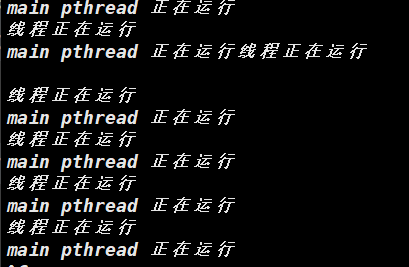
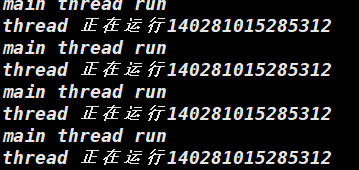
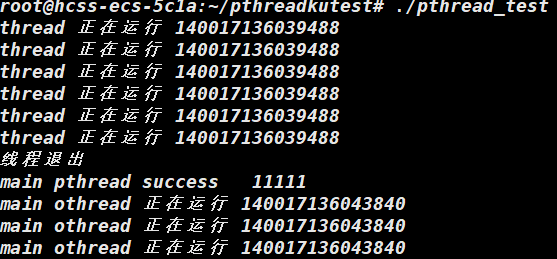

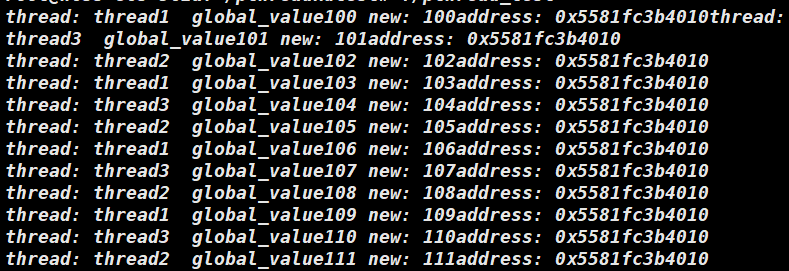







![[硬件電路-166]:Multisim - SPICE與Verilog語言的區別](http://pic.xiahunao.cn/[硬件電路-166]:Multisim - SPICE與Verilog語言的區別)










 --- 高級查詢與函數篇)

